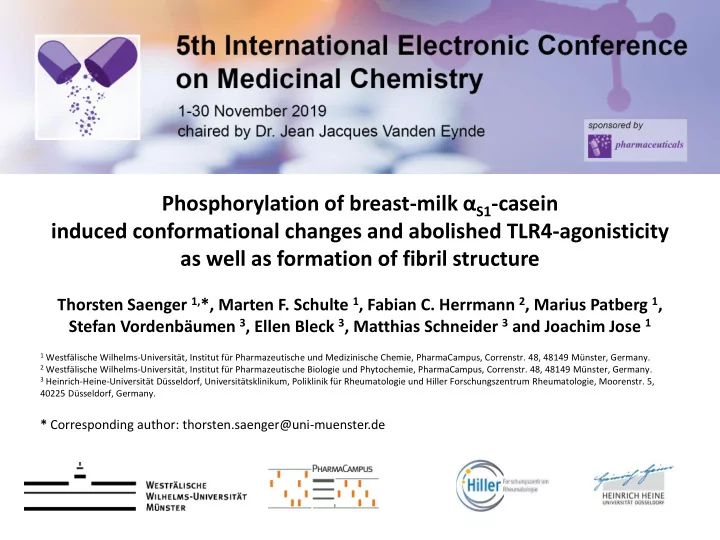

Phosphorylation of breast- milk α S1 -casein induced conformational changes and abolished TLR4-agonisticity as well as formation of fibril structure Thorsten Saenger 1, *, Marten F. Schulte 1 , Fabian C. Herrmann 2 , Marius Patberg 1 , Stefan Vordenbäumen 3 , Ellen Bleck 3 , Matthias Schneider 3 and Joachim Jose 1 1 Westfälische Wilhelms-Universität, Institut für Pharmazeutische und Medizinische Chemie, PharmaCampus, Correnstr. 48, 48149 Münster, Germany. 2 Westfälische Wilhelms-Universität, Institut für Pharmazeutische Biologie und Phytochemie, PharmaCampus, Correnstr. 48, 48149 Münster, Germany. 3 Heinrich-Heine-Universität Düsseldorf, Universitätsklinikum, Poliklinik für Rheumatologie und Hiller Forschungszentrum Rheumatologie, Moorenstr. 5, 40225 Düsseldorf, Germany. * Corresponding author: thorsten.saenger@uni-muenster.de
Phosphorylation of breast-milk α S1 -casein induced conformational changes and abolished TLR4-agonisticity as well as formation of fibril structure Graphical Abstract 2
Abstract: Breast-milk α S1 -casein is a Toll-like receptor (TLR4) agonist which induced proinflammatory cytokine secretion. Phosphorylated α S1 -casein (P- α S1 -casein) is non- agonistic. The objective of this study was to analyze structural characteristics underlying these observations. Recombinant α S1 -casein was shown to exist in two conformations, an α -helical TLR4- agonistic conformation and a non-agonistic conformation with lower α helical and higher random coil content. TLR4-agonstic α S1 -casein conformation was found at a pH-range between 7.4 and 2. α S1 -Casein bound itself (KD-value: 2 µM) formed large aggregates (between Ø 73 nm [pH7] and Ø 826.2 nm [pH2]). Using Thioflavin T assay and atomic force microscopy showed that α S1 -casein adopted fibril-like structure. P- α S1 -casein was observed in a less α helical conformation, not inducing IL-8 secretion. P- α S1 -casein bound itself stronger (KD-value: 0.5 µM) than α S1 -casein and did not form fibrils. In conclusion, TLR4-agonistic and non-agonistic conformations of α S1 -casein could be differentiated. It was demonstrated that human caseins are able to adopt fibril structure. These kind of structures are often disease related. We postulate, that phosphorylation could be a switch of two conformations regulating immunomodulatory effects of human α S1 -casein especially in immune system development. Keywords: Breast milk; human α S1 -casein; TLR4 agonist; fibril structure, CK2. 3
Human α S1 -casein Phosphorylation of α S1 -casein abolished this. Expressed in: Breast- and prostate cancer Synovia of patients (arthritis) TLR4/MD2/CD14 breast milk (functional food) transport of molecules, minerals induces life long IgG response MyD88 My TRI TRIF proin pr oinfla lammatory ry antii an iinfla flammatory ry α S1 -casein bound TLR4-receptors MAP MAPK p3 p38 ERK 1/2, JNK, p38 In vitro phosphorylated α S1 -casein did not bind TLR4-receptors IL-1 β , IL-6, IL IL-8 8 CD14 and CD64 Is there a structure-function relationship for α S1 -casein activating TLR4?
In silico predicted structure and in vitro analysis α S1 -casein (intrinsically) disordered ordered flexible structure, known phosphorylation site conserved structure, less accessable K98 S89 S89 S41 S41 S33 S33 • partial α -helical structure 1. ratio (222 nm/208 nm) of 0.74 2. maxima at 1661 nm • high intensity for used concentration (CD) result of multimerization? • maxima at 1625 nm ( β -sheet? ) 5
α S1 -casein binds itself? (intrinsically) disordered ordered flexible structure, known phosphorylation site conserved structure, less accessable K98 S89 S41 S33 Microsale Thermophoresis • Homomers • „K D -value : 2.2 µM“ • Diameter of particels: 73.4 nm (PI: 0.6) α S1 -casein binds to itsself 6
Correlation of α -helical structure and effects via TLR4 IL-8 sercretion via TLR4 • RT, pH7: yes • 95 °C: no • Phosphorylation: no • pH2: yes α -helix minima random coil increase temperature α -helical decrease α -helix less α -helical α S1 -casein had higher α -helical content at RT (pH7 and pH2) than phosphorylated and heated one 7
Difference in binding of α S1 -casein to itself S89 S41 S33 SPR 8000 6000 Phosphorylated: 0.5 µM µRU 4000 Higher affinity, faster binding to itself 2000 Unphosphorylated: 2 µM 0 0 1 2 3 4 5 µM Phosphorylation could be a mechanism to control multimerization Unphosphorylated: slower, structured Phosphorylated: faster, unstructured 8
β -Sheet content and multimerization hint that α S1 -casein could form fibril structures fibrils Unphosphorylated α S1 -casein formed fibrils (shown by Thioflavin T Assay and AFM) Phosphorylated α S1 -casein did not form fibrils, but aggregates. 9
Conclusions (intrinsically) disordered ordered flexible structure, known phosphorylation site conserved structure, less accessable K98 S89 S89 S41 S41 S33 S33 • α S1 -casein was shown to have two conformations, an α -helical TLR4-agonistic and a non- agonistic conformation with lower α helical content. • Phosphorylation of α S1 -casein as well as incubation at 80 °C led to the non-agonistic conformation. • β -Sheets and aggregation allowed us to identify fibril- like structures of specifically for α S1 - casein by ThT-assay and AFM • phosphorylation could be a switch between two conformations of α S1 -casein regulating immunomodulatory processes of the immune system 10
Acknowledgments Thanks to all members of the Group of Joachim Jose Financial support of Hiller Rheumatology Research Foundation and Hiller Research Center Rheumatology of Heinrich-Heine- University Düsseldorf 11
Recommend
More recommend